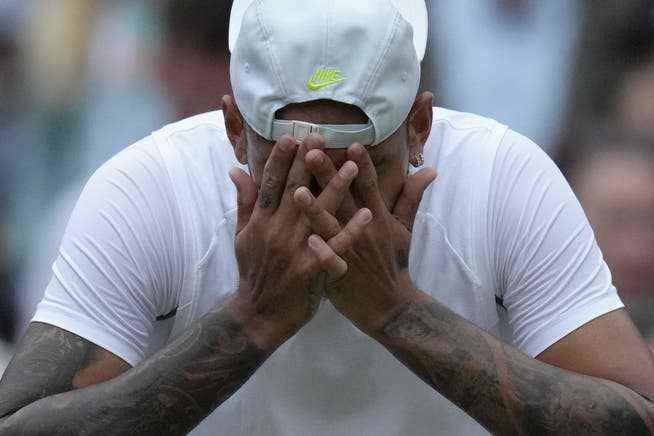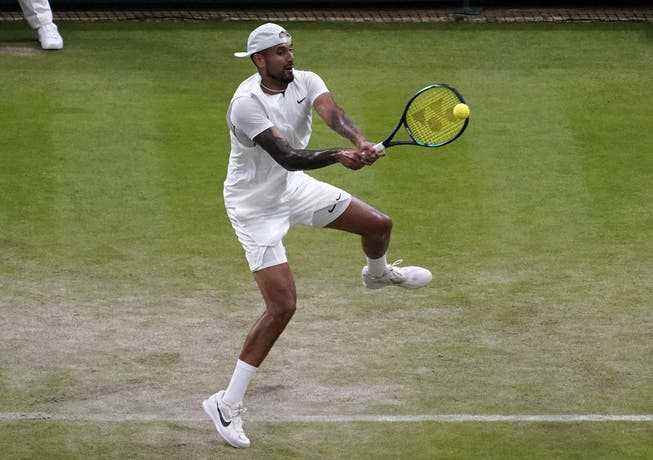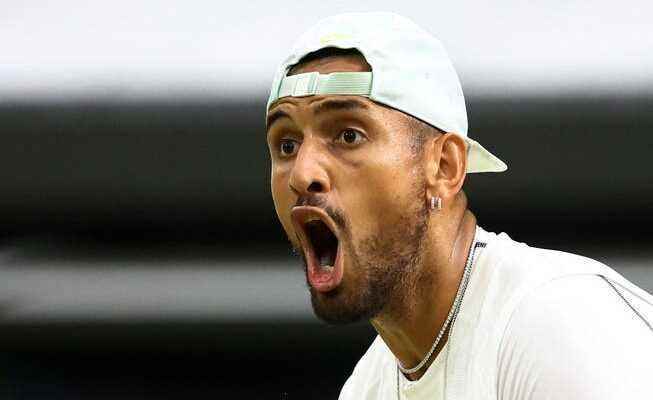Kyrgios confirms his reputation as a lout against Tsitsipas. But more than that, the Australian is a gifted tennis player. A semi-final qualification in the current tournament seems realistic.
Nick Kyrgios, a player between genius and madness.
The Wimbledon tournament is only halfway through. On this occasion, for the first time, games will also be played on the middle Sunday. And everything seems to come to a head in the fight for the title in another duel between Novak Djokovic and Rafael Nadal. But the big story of the tournament may have been written in the third round.
Nick Kyrgios wrestled Stefanos Tsitsipas on Saturday to reach the second week of the tournament at Wimbledon for the fourth time. In 2014 he first drew attention to himself with his victory in the round of 16 against Nadal. But at the age of 27, the Australian is still waiting for his first major title. Six smaller tournament victories are the modest yield of his immense talent.
Kyrgios has so far paid more than CHF 500,000 in fines
Far longer than the list of his successes is that of his buses. A month ago he said in a podcast that he had calculated that he had had to pay a fine of around 800,000 Australian dollars to date, which is the equivalent of around 520,000 Swiss francs. And not all of them were justified. «When you see what other players are sometimes guilty of; I would probably have been banned for three or four years.”
In 2016, Kyrgios demonstratively gave away victory in a match against Alexander Zverev at the Masters 1000 tournament in Shanghai. He stood on the baseline and no longer reacted to the German’s serves. The ATP then suspended him for eight weeks, but reduced this sentence to three weeks after Kyrgios agreed to get help from a psychologist.

Nick Kyrgios is known for his freak outs, which often earn him bans and penalties.
Less than two years later, in his second-round match against Frenchman Pierre-Hugues Herbert, he walked listlessly across the court at the US Open with a towel between his teeth, signaling that at that moment he would rather be anywhere else in the world than on a court , where tennis is played competitively. The renowned referee Mohamed Lahyani got down from his chair, spoke to Kyrgios and was temporarily suspended by the ATP for illegal coaching.
Nick Kyrgios is not the most successful player on the ATP tour. But when he’s on the pitch, something always works. This makes him one of the most popular players on the scene. But for the etiquette-minded tennis community, he’s a bogeyman.
In his first-round match at this year’s Wimbledon tournament against the British Paul Jubb, he had already messed with the audience and, after the match, rudimentarily spat in the direction of a group of spectators who had repeatedly tried to provoke him. When he was then asked at the media conference whether he actually spat, he said: “Yes, the man didn’t respect me. I would never do that against a supporter of mine.” He stuffed sushi into his mouth.
Against Tsitsipas more victims than perpetrators
In the most recent incident against Stefanos Tsitsipas, however, Kyrgios was more a victim than a perpetrator. The trigger was a ball that the Greek smashed into the audience and with which he almost hit a spectator. Tsitsipas received a warning for this – which Kyrgios was terribly upset about because he was surprised that Tsitsipas was not punished more severely. “When Djokovic met a line judge at the US Open 2020, he was disqualified for it,” Kyrgios complained to the chair umpire. The Australian then asked to speak to the tournament referee. Otherwise he will not continue playing.
From that moment on, the atmosphere on the pitch was poisoned. Tsitsipas tried to hit Kyrgios with the ball more than once. The handshake at the end of the match was correspondingly cool and sober after Kyrgios had won in four sets. At the media conference that followed, Tsitsipas first apologized for his freak, but then described his opponent as a bully who had nothing in mind but to tyrannize his opponents on the pitch. ‘The circus he puts on is getting tiring. I think we players should get together and do something about it.”
The handshake we were all waiting to see between Kyrgios and Tsitsipas that was never shown?#Wimbledon pic.twitter.com/h3KLmzJzk3
— Ochieng’ Stephen (@soo_ochieng) July 2, 2022
Kyrgios, who described Tsitsipas in the interview after the win as a wonderful player whom he appreciates very much, was unimpressed by his opponent’s harsh criticism. He had already defeated the Greek three weeks ago at the tournament in Halle and therefore said: “If I lost to the same player twice in a row, I would be angry too. Maybe he should think better about how to beat me.”
It was far from the end of the taunts. At the end of his media conference, Kyrgios said: «I have many friends in the dressing room, you should know that. In fact, I’m one of the most popular players among the competition.” Tsitsipas, on the other hand, is not so appreciated – “only that it is also mentioned.”

Nick Kyrgios has a good chance of going far at Wimbledon this year.
Kyrgios cultivates trash talk as an art form
Professional team sports have a term for such behavior. It’s called “trash talk”, jibes used to try to tear the opponent out of concentration. The best-known example of this is the provocation by Italian footballer Marco Materazzi, who is said to have insulted Zinedine Zidane’s sister in the 2006 World Cup final, after which the Frenchman headbutted Materazzi. Zidane was sent off, Italy became world champions.
But such behavior is unusual in tennis. The generation around Roger Federer and Rafael Nadal in particular cultivates an almost overly correct way of dealing with each other. Only Novak Djokovic and his family occasionally cross lines, which then triggers corresponding indignation. An angry tennis fan wrote on Twitter after the incidents in the match between Kyrgios and Tsitsipas: “A game for gentlemen, played by hooligans.”
How the arguments started, defaulting the match argument against #Tsitsipas #Kyrgios could have won this match if that ball had hit a spectator
Kyrgios argument was the violent intent should have been enough to be given the win.#Wimbledon#Wimbledon2022 pic.twitter.com/oA6oxwfth8
— RESPONDI433 (@Respondi433) July 2, 2022
Kyrgios consciously searches for these limits. That’s not only part of his tactics on the pitch, but above all his image. He likes to flirt with the fact that he would actually rather have been a basketball player than a tennis player. The American enfant terrible, Dennis Rodman, is his idol. Kyrgios appears again and again in basketball clothes on the court. When basketball legend Kobe Bryant died in a helicopter crash during the Australian Open 2020, Kyrgios warmed up in his dress. He then had the icon’s shirt number tattooed on his forearm.
On Saturday, Kyrgios said he didn’t want to be Rodman or anyone else. He tries to stay himself. In the tennis circus with all its rules, this is not always easy. Then he said, “I’m not trying to be nice. I honestly have to admit that. I don’t really care what other people think of me either. I’m in the fourth round of Wimbledon and I’m getting a pretty decent check.”
Kyrgios has a good chance that this sum will be even larger. In the round of 16 on Monday he meets the young American Brandon Nakashima (ATP 56). After that, his opponent would be his compatriot Alex De Minaur (ATP 27) on paper, Rafael Nadal would probably wait in the semifinals. But Kyrgios proved in 2014 that he can also beat him on grass. He is capable of anything this year at Wimbledon – in a positive as well as in a negative sense.
